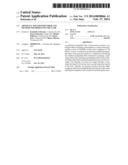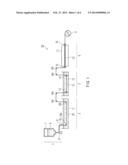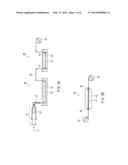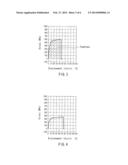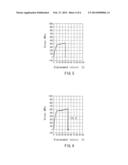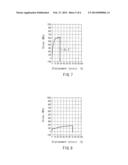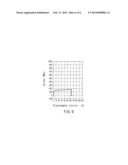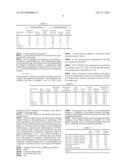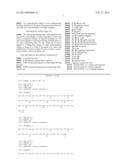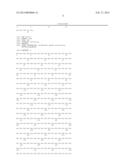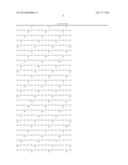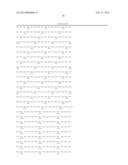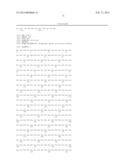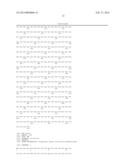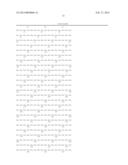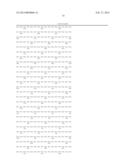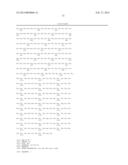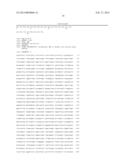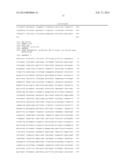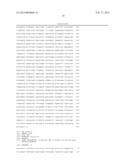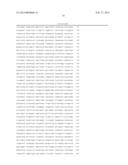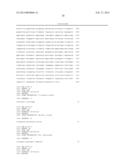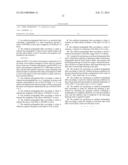Patent application title: ARTIFICIAL POLYPEPTIDE FIBER AND METHOD FOR PRODUCING THE SAME
Inventors:
Kazuhide Sekiyama (Tsuruoka-Shi, JP)
Kaori Sekiyama (Osaka, JP)
Mizuki Ishikawa (Tsuruoka-Shi, JP)
Ryota Sato (Truoka-Shi, JP)
Shinya Murata (Tsuroka-Shi, JP)
Assignees:
SPIBER INC.
IPC8 Class: AC07K14435FI
USPC Class:
530353
Class name: Chemistry: natural resins or derivatives; peptides or proteins; lignins or reaction products thereof proteins, i.e., more than 100 amino acid residues scleroproteins, e.g., fibroin, elastin, silk, etc.
Publication date: 2014-02-27
Patent application number: 20140058066
Abstract:
An artificial polypeptide fiber of the present invention is an artificial
fiber containing a polypeptide as a main component, and has a stress of
350 MPa or more and a toughness of 138 MJ/m3 or more. A method for
producing an artificial polypeptide fiber of the present invention is a
method for producing the artificial polypeptide fiber obtained by
spinning a spinning solution (6) containing a polypeptide derived from
natural spider silk proteins and performing drawing of at least two
stages. The drawing of at least two stages includes a first-stage drawing
(3) in wet heat and a second-stage drawing (4) in dry heat. Thereby, the
present invention provides high-toughness artificial polypeptide fibers
having favorable stress and rupture elongation, and a method for
producing the same.Claims:
1. An artificial polypeptide fiber that is an artificial fiber containing
a polypeptide as a main component, and has a stress of 350 MPa or more
and a toughness of 138 MJ/m3 or more.
2. The artificial polypeptide fiber according to claim 1, wherein the polypeptide is derived from natural spider silk proteins and contains a unit of an amino acid sequence represented by the formula 1: REP1-REP2 (1), where the REP1 is an amino acid sequence composed of 2 to 20 amino acid residues arranged in series that are selected from at least one of alanine and glycine; and the REP2 is an amino acid sequence composed of 2 to 200 amino acid residues, and the total number of glycine, serine, glutamine and alanine residues contained in the amino acid sequence is 40% or more with respect to the total number of amino acid residues contained therein.
3. The artificial polypeptide fiber according to claim 2, wherein the polypeptide has, at a C-terminal, an amino acid sequence represented by any of SEQ ID NOS: 1 to 3 or an amino acid sequence having a homology of 90% or more with the amino acid sequence represented by any of SEQ ID NOS: 1 to 3.
4. The artificial polypeptide fiber according to claim 1, wherein the toughness of the fiber is 170 MJ/m3 or more.
5. The artificial polypeptide fiber according to claim 4, wherein the toughness of the fiber is 240 MJ/m3 or more.
6. The artificial polypeptide fiber according to claim 1, wherein the stress of the fiber is 590 MPa or more.
7. The artificial polypeptide fiber according to claim 1, wherein a rupture elongation of the fiber is 26% or more.
8. The artificial polypeptide fiber according to claim 1, wherein an initial elastic modulus of the fiber is 8 GPa or more.
9. The artificial polypeptide fiber according to claim 1, wherein a variation of a diameter of the fiber is 5% or less.
10. The artificial polypeptide fiber according to claim 1, wherein the diameter of the fiber ranges from 5 to 100 μm.
11. A method for producing an artificial polypeptide fiber that is obtained by spinning a spinning solution containing a polypeptide derived from natural spider silk proteins and performing drawing of at least two stages, wherein the drawing of at least two stages includes a first-stage drawing in wet heat and a second-stage drawing in dry heat.
12. The method for producing an artificial polypeptide fiber according to claim 11, wherein drawing conditions for the first-stage drawing include a temperature of hot water of 70-90.degree. C. and a draw ratio of 2 to 8 times.
13. The method for producing an artificial polypeptide fiber according to claim 11, wherein drawing conditions for the second-stage drawing include an ambient temperature of 170 to 230.degree. C. and a draw ratio of 1.25 to 3 times.
14. The method for producing an artificial polypeptide fiber according to claim 11, wherein the spinning is performed by extruding the spinning solution containing a polypeptide in a coagulation liquid so as to obtain an undrawn yarn, and the undrawn yarn is subjected to the first-stage drawing in the coagulation liquid.
15. The method for producing an artificial polypeptide fiber according to claim 11, wherein a total draw ratio of the fiber is more than 5 times and 20 times or less.
Description:
TECHNICAL FIELD
[0001] The present invention relates to an artificial polypeptide fiber that is one kind of synthetic protein fibers and a method for producing the same.
BACKGROUND ART
[0002] Spider silk fibers are fibers having high strength and toughness, and are known to have higher strength and toughness than high-tensile steels, nylon 6 fibers, aramid fibers, carbon fibers, etc. In addition, they have an advantage in that oil is not used as a raw material and biomass can be used instead. Some artificial spider silk fibers also have been proposed. For example, Patent Document 1 has proposed a fiber produced by extruding a synthetic protein spinning solution into a coagulation bath with 90% methanol from a spinneret at a speed of 5 to 10 μl/min. Patent Document 2 has proposed a fiber 1 μm or more in diameter and 5 mm or more in length having a tensile strength of 200 MPa or higher. Non-Patent Document 1 has disclosed a drawn yarn having a strength of 1.91 to 2.26 g/d and an elongation of 43.4 to 59.6% obtained by drawing a yarn at a draw ratio of 5 times in a methanol bath and a water bath. Non-Patent Document 2 has disclosed a drawn yarn having a stress of 600 MPa and an elongation of 25% obtained by drawing a yarn at a draw ratio of 5 times. Non-Patent Document 3 has disclosed a drawn yarn having a stress of 280 to 350 MPa and an elongation of 30 to 40% obtained by keeping a yarn in steam for 5 minutes so as to draw the yarn to 5 times.
[0003] However, the toughness of conventional artificial polypeptide fibers is not sufficiently high, and hence tenacious fibers having still higher stress have been desired.
PRIOR ART DOCUMENTS
Patent Documents
[0004] Patent Document 1: JP 2004-503204 A
[0005] Patent Document 2: JP 2009-521921 A
Non-Patent Documents
[0006] Non-Patent Document 1: Anthoula Lazaris, et. al., "Spider Silk Fiber Spun from Soluble Recombinant Silk Produced in Mammalian Cells", Science, 295, page 472, Jan. 18, 2002
[0007] Non-Patent Document 2: Xiao-Xia Xia, et. al., "Native-sized recombinant spider silk protein produced in metabolically engineered Escherichia coli results in a strong fiber", PNAS, vol. 107, No. 32, pages 14059-14063, Aug. 10, 2010
[0008] Non-Patent Document 3: M. Elice, et. al., "Bioinspired Fibers Follow the Track of Natural Spider Silk", Macromolecules, Vol. 44, No. 5, pages 1166-1176, Apr. 2, 2011
DISCLOSURE OF INVENTION
Problem to be Solved by the Invention
[0009] In order to solve the above-described conventional problem, the present invention provides an artificial polypeptide fiber having high stress and toughness, and a method for producing the same.
Means for Solving Problem
[0010] An artificial polypeptide fiber of the present invention is an artificial fiber containing a polypeptide as a main component, and has a stress of 350 MPa or more and a toughness of 138 MJ/m3 or more.
[0011] A method for producing an artificial polypeptide fiber of the present invention is a method for producing an artificial polypeptide fiber that is obtained by spinning a spinning solution containing a polypeptide derived from natural spider silk proteins and performing drawing of at least two stages. The drawing of at least two stages includes a first-stage drawing in wet heat and a second-stage drawing in dry heat.
Effect of the Invention
[0012] The present invention can provide an artificial polypeptide fiber having high stress and toughness by drawing an undrawn fiber made of artificial polypeptide through at least two stages in wet heat and dry heat, and a method for producing the same. Specifically, it is possible to realize an artificial polypeptide fiber having a stress of 350 MPa or more and a toughness of 138 MJ/m3 or more. The fiber having high stress and high toughness is advantageous as a composite material formed with metal, resin, rubber, etc.
BRIEF DESCRIPTION OF DRAWINGS
[0013] FIG. 1 illustrates a production process in one example of the present invention.
[0014] FIGS. 2A and 2B illustrate a production process in another example of the present invention. FIG. 2A shows a spinning process and a first-stage drawing process, and FIG. 2B shows a second-stage drawing process.
[0015] FIG. 3 shows a stress-displacement (strain) curve of a fiber obtained in Example 1 of the present invention.
[0016] FIG. 4 shows a stress-displacement (strain) curve of a fiber obtained in Example 2 of the present invention.
[0017] FIG. 5 shows a stress-displacement (strain) curve of a fiber obtained in Example 3 of the present invention.
[0018] FIG. 6 shows a stress-displacement (strain) curve of a fiber obtained in Example 4 of the present invention.
[0019] FIG. 7 shows a stress-displacement (strain) curve of a fiber obtained in Example 5 of the present invention.
[0020] FIG. 8 shows a stress-displacement (strain) curve of a fiber obtained in Comparative Example 1.
[0021] FIG. 9 shows a stress-displacement (strain) curve of a fiber obtained in Comparative Example 2.
DESCRIPTION OF THE INVENTION
[0022] (1) Polypeptide
[0023] An artificial polypeptide fiber of the present invention contains a polypeptide as a main component. In the present invention, the term "main component" refers to a component contained in an amount of 80% by mass (mass %) or more, more preferably contained in an amount of 90 mass % or more, and further preferably contained in an amount of 95 mass % or more. Incidentally, the artificial polypeptide fiber of the present invention may contain components other than polypeptides within a range that do not inhibit the effect of the present invention. In the present invention, as a raw material, it is desirable to use a polypeptide derived from natural spider silk proteins. Examples of the polypeptide derived from natural spider silk proteins include variants, analogs, derivatives or the like of the natural spider silk proteins. The polypeptide is not limited particularly insofar as it is derived from natural spider silk proteins. In terms of obtaining excellent tenacity, the polypeptide preferably is derived from spigot dragline proteins produced in the major ampullate glands of spiders. Examples of the spigot dragline proteins include major ampullate spidroin MaSp1 and MaSp2 derived from Nephila clavipes, and ADF3 and ADF4 derived from Araneus diadematus, etc. Examples of the polypeptide derived from the spigot dragline proteins include variants, analogs, derivatives or the like of the spigot dragline proteins.
[0024] Examples of the polypeptide derived from the spigot dragline proteins include a polypeptide containing two or more units of an amino acid sequence represented by the formula 1:
REP1-REP2(1), (1)
preferably a polypeptide containing five or more units thereof, and more preferably a polypeptide containing ten or more units thereof. Alternatively, the polypeptide derived from the spigot dragline proteins may be a polypeptide that contains units of the amino acid sequence represented by the formula 1:
REP1-REP2 (1)
and that has, at a C-terminal, an amino acid sequence represented by any of SEQ ID NOS: 1 to 3 or an amino acid sequence having a homology of 90% or more with the amino acid sequence represented by any of SEQ ID NOS: 1 to 3. Incidentally, in the polypeptide derived from the spigot dragline proteins, units of the amino acid sequence represented by the formula (1):
REP1-REP2 (1)
may be the same or may be different from each other. Here, the units of the amino acid sequence represented by [REP1-REP2 (1)] 1 being different from each other includes cases where the REP1 is different, the REP2 is different, and both of the REP1 and REP2 are different. As to the polypeptide derived from the spigot dragline proteins, when producing a recombinant protein using a microbe such as Escherichia coli as a host, the molecular weight is preferably 300 kDa or less, more preferably 200 kDa or less, and further preferably 150 kDa or less, in view of productivity.
[0025] In the formula (1) above, the REP1 is an amino acid sequence composed of 2 to 20 amino acid residues arranged in series that are selected from at least one of alanine and glycine, more preferably 3 to 16 amino acid residues arranged in series selected therefrom, further preferably 4 to 12 amino acid residues arranged in series selected therefrom, and most preferably 5 to 8 amino acid residues arranged in series selected therefrom. In the formula (1) above, the REP2 is an amino acid sequence composed of 2 to 200 amino acid residues, more preferably 10 to 150 amino acid residues, further preferably 20 to 100 amino acid residues and most preferably 20 to 75 amino acid residues, and the total number of glycine, serine, glutamine and alanine residues contained in the amino acid sequence is 40% or more, preferably 60% or more, and more preferably 70% or more with respect to the total number of amino acid residues contained therein.
[0026] In the spigot dragline, the above REP1 corresponds to a crystal region in a fiber where a crystal β sheet is formed, and the above REP2 corresponds to an amorphous region in a fiber where most of parts lack regular configurations and that has more flexibility. Further, the above [REP1-REP2] corresponds to a repetitious region (repetitive sequence) composed of the crystal region and the amorphous region, which is a characteristic sequence of dragline proteins.
[0027] An amino acid sequence represented by SEQ ID NO: 1 is identical to an amino acid sequence that is composed of 50 amino acid residues of an amino acid sequence of ADF3 (GI: 1263287, NCBI) from the C-terminal. An amino acid sequence represented by SEQ ID NO: 2 is identical to an amino acid sequence represented by SEQ ID NO: 1 in which 20 amino acid residues have been removed from the C-terminal. An amino acid sequence represented by SEQ ID NO: 3 is identical to an amino acid sequence represented by SEQ ID NO: 1 in which 29 amino acid residues have been removed from the C-terminal.
[0028] An example of the above-described polypeptide that contains units of the amino acid sequence represented by the formula 1:
REP1-REP2 (1)
and that has, at a C-terminal, an amino acid sequence represented by any of SEQ ID NOS: 1 to 3 or an amino acid sequence having a homology of 90% or more with the amino acid sequence represented by any of SEQ ID NOS: 1 to 3 is a polypeptide having an amino acid sequence represented by SEQ ID NO: 4. The polypeptide having an amino acid sequence represented by SEQ ID NO: 4 is one obtained by the following mutation: in an amino acid sequence of ADF3 to which an amino acid sequence (SEQ ID NO: 7) composed of a start codon at a N-terminal, His 10 tags and an HRV3C Protease (Human rhinovirus 3C Protease) recognition site has been added, 1st to 13th repetitive regions are about doubled and the translation ends at the 1154th amino acid residue. In the polypeptide having the amino acid sequence represented by SEQ ID NO: 4, the C-terminal sequence is identical to the amino acid sequence represented by SEQ ID NO: 3.
[0029] Further, another example of the above-described polypeptide that contains units of the amino acid sequence represented by the formula 1:
REP1-REP2 (1)
and that has, at a C-terminal, an amino acid sequence represented by any of SEQ ID NOS: 1 to 3 or an amino acid sequence having a homology of 90% or more with the amino acid sequence represented by any of SEQ ID NOS: 1 to 3 is a protein that has an amino acid sequence represented by SEQ ID NO: 4 in which one or a plurality of amino acids have been substituted, deleted, inserted and/or added and that has the repetitious region composed of the crystal region and the amorphous region. In the present invention, "one or a plurality of" refers to 1 to 40, 1 to 35, 1 to 30, 1 to 25, 1 to 20, 1 to 15, 1 to 10, or 1 or a few, for example. Further, in the present invention, "one or a few" refers to 1 to 9, 1 to 8, 1 to 7, 1 to 6, 1 to 5, 1 to 4, 1 to 3, 1 to 2, or 1.
[0030] The polypeptide can be produced using a host that has been transformed by an expression vector containing a gene encoding a polypeptide. A method for producing a gene is not limited particularly, and it may be produced by amplifying a gene encoding a natural spider silk protein from a cell derived from spiders by a polymerase chain reaction (PCR) or the like for cloning, or may be synthesized chemically. A method for chemically synthesizing a gene also is not limited particularly, and it can be synthesized as follows, for example: based on information of amino acid sequences of natural spider silk proteins obtained from the NCBI web database, etc., oligonucleotides that have been synthesized automatically with AKTA oligopilot plus 10/100 (GE Healthcare Japan Corporation) are linked by PCR or the like. At this time, in order to facilitate the purification and observation of protein, it is possible to synthesize a gene that encodes a protein having an amino acid sequence of the above-described amino acid sequence to which an amino acid sequence composed of a start codon and His 10 tags has been added, to the N-terminal. Examples of the expression vector include a plasmid, a phage, a virus, etc., that can express protein from a DNA sequence. The plasmid type expression vector is not limited particularly insofar as it allows expression of a target gene in a host cell and it can amplify itself. For example, in the case of using Escherichia coli Rosetta (DE3) as a host, a pET22b(+) plasmid vector, a pCold plasmid vector and the like can be used. Among these, in view of productivity of protein, it is preferable to use the pET22b(+) plasmid vector. Examples of the host include animal cells, plant cells, microbes, etc.
[0031] (2) Spinning Solution
[0032] A spinning solution (dope solution) is prepared by adding a solvent to the above-described polypeptide and adjusting the viscosity to allow spinning. The solvent is not limited particularly insofar as it can dissolve the polypeptide. For example, if the polypeptide is derived from Araneus diadematus, as an example, a solution containing hexafluoroisopropanol (HFIP), hexafluoroacetone (HFA), formic acid, urea, guanidine, sodium dodecyl sulfate (SDS), lithium bromide, calcium chloride, lithium thiocyanate or the like is used as a solvent and the solvent is added to the polypeptide in an appropriate amount so that the viscosity of the solution becomes 100 to 10,000 cP (centipoises). This is defined as the spinning solution.
[0033] (3) Spinning
[0034] Wet spinning is adopted as the spinning. By this method, the solvent dissolving a polymer is removed (also called as desolvation) and an undrawn yarn is obtained. A coagulation liquid to be used for the wet spinning is not limited particularly insofar as it allows desolvation. When the solvent is HFIP, the coagulation liquid preferably is a lower alcohol with a carbon number of 1 to 5 such as methanol, ethanol and 2-propanol, or acetone. The temperature of the coagulation liquid preferably is 0-30° C. This range stabilizes spinning. By extruding the spinning solution into the coagulation liquid, an undrawn yarn is obtained. When using a syringe pump with a nozzle 0.1-0.6 mm in diameter, the extrusion speed preferably is set at 0.2-2.4 ml/h per one hole. This range stabilizes spinning. The further preferable extrusion speed is 0.6-2.2 ml/h per one hole. It is preferable that a length of a coagulation liquid bath is 200-500 mm, a take-up speed of the undrawn yarn is 1-3 m/min, and residence time is 0.01-0.15 min. These ranges allow efficient desolvation. Drawing (pre-drawing) may be performed in the coagulation liquid. However, taking into consideration the evaporation of a lower alcohol, it is preferable to maintain the coagulation liquid at low temperature so as to take up yarns in an undrawn state.
[0035] (4) Drawing
[0036] (a) Function of Multistage Drawing
[0037] Drawing is performed in at least two stages. Of course, it also is possible to adopt multistage drawing with three or more stages. In the present invention, the reason for adopting the multistage drawing of two or more stages is as follows. Since molecules of polypeptides derived from natural spider silk proteins are less likely to be oriented, the multistage drawing is performed so as to orient the molecules stepwise and increase the total draw ratio. Consequently, high-toughness fibers can be obtained.
[0038] (b) Contents of Multistage Drawing
[0039] The drawing of at least two stages includes a first-stage drawing in wet heat and a second-stage drawing in dry heat. The first-stage drawing in wet heat may be performed in the above-described coagulation liquid. When adopting the multistage drawing of three or more stages, it is possible to adopt a method of, for example, dividing the first-stage drawing in wet heat into two stages and/or dividing the second-stage drawing in dry heat into two stages. The wet heat of the first-stage drawing may be performed in hot water or by steam heating. An organic solvent, etc., may be added to the hot water. The multistage drawing may include a drawing method other than the wet heat or dry heat in any stage of the drawing process.
[0040] (c) Drawing Conditions for First and Second Stages
[0041] In the first-stage drawing, it is preferable to draw an undrawn yarn to 2 to 8 times in hot water at 50-90° C. This allows stable drawing. In the second-stage drawing, it is preferable to draw a yarn to 1.25 to 3 times in dry heat at 170-270° C. This provides a high-toughness drawn yarn. In the first-stage drawing described above, it is further preferable to draw an undrawn yarn in hot water at 75-85° C.
[0042] The draw ratio of the first-stage drawing further preferably is to 2.3 to 7 times. In the second-stage drawing, the dry heat further preferably is set at 180-230° C. The draw ratio of the second-stage drawing further preferably is to 1.35 to 3 times. For improving the toughness of drawn yarns and obtaining them stably, the total draw ratio is preferably to more than 5 times and 20 times or less, and further preferably to 6 times or more and 11 times or less. As an example, the dry heat is performed using an electric tubular furnace or a heat plate.
[0043] (d) Continuous Process
[0044] The spinning and drawing may be performed as a continuous process or may be divided into any combination of processes. FIG. 1 illustrates a production process in one example of the present invention. FIG. 1 shows a continuous process. A spinning-drawing apparatus 10 includes an extrusion process 1, an undrawn-yarn production process 2, a wet-heat drawing process 3, and a dry-heat drawing process 4. A spinning solution 6 is stored in a storage tank 7 and extruded from a gear pump 8 to a spinneret 9. In a laboratory scale, a spinning solution may be filled in a cylinder and extruded from a nozzle using a syringe pump. The extruded spinning solution is supplied directly or via an air gap 19 into a coagulation liquid 11 of a coagulation liquid bath 20, and thus a solvent is removed. Then, an obtained yarn is supplied into hot water 12 in a drawing bath 21 and subjected to the first-stage drawing. The drawing depends on a speed ratio between a supply nip roller 13 and a take-up nip roller 14. Next, the yarn is supplied to a dry-heat drawing machine 17 and subjected to the second-stage drawing inside a guide 22, whereby a yarn roll 5 is obtained. The drawing depends on a speed ratio between a supply nip roller 15 and a take-up nip roller 16. 18a to 18f are yarn guides.
[0045] (e) Separated Process
[0046] FIGS. 2A and 2B illustrate a case in which the production process is separated in another example of the present invention. FIG. 2A shows a spinning process 30 and a first-stage drawing process 40, and FIG. 2B shows a second-stage drawing process 50. In each process, a yarn may be wound or may be stored in a container without being wound. In the spinning process 30, a spinning solution 32 is contained in a microsyringe 31 and moved in a direction indicated by an arrow P using a syringe pump, so that the spinning solution 32 is extruded from a nozzle 33 and supplied into a coagulation liquid 35 in a coagulation liquid bath 34. Thus, an undrawn yarn 36 is obtained. Then, in the first-stage drawing process 40, the undrawn yarn 36 is supplied into hot water 38 of a drawing bath 37 and subjected to the first-stage drawing, whereby a yarn roll 39 of the first-stage drawn yarn is obtained. The drawing depends on a speed ratio between a supply nip roller 41 and a take-up nip roller 42. Next, the first-stage drawn yarn is unwound from the yarn roll 39, supplied to a dry-heat drawing machine 43, and subjected to the second-stage drawing inside a guide 47. The drawing depends on a speed ratio between a supply nip roller 45 and a take-up nip roller 46. Then, the drawn yarn is wound as a yarn roll 44.
[0047] In the above-described manner, an artificial polypeptide fiber is obtained. The obtained artificial polypeptide fiber has a stress of 350 MPa or more and a toughness of 138 MJ/m3 or more. The toughness is calculated from an integral value of a stress-strain curve (SS curve) at the time of measuring the strength elongation of the fiber. FIG. 3 illustrates the toughness of the fiber obtained in one example of the present invention, and shows a stress-displacement (strain) curve and toughness (shaded part). This indicates that, when the stress and rupture elongation are both high, the toughness also is high.
[0048] The stress of the artificial polypeptide fiber of the present invention is preferably 400 MPa or more, more preferably 590 MPa or more, and particularly preferably 620 MPa or more. The rupture elongation is preferably 39% or more, more preferably 45% or more, and further preferably 50% or more. The toughness is preferably 170 MJ/m3 or more, more preferably 240 MJ/m3 or more, and further preferably 260 MJ/m3 or more. An initial elastic modulus of the artificial polypeptide fiber of the present invention is preferably 8 GPa or more, more preferably 14 GPa or more, and further preferably 16 GPa or more.
[0049] The diameter of the artificial polypeptide fiber of the present invention preferably ranges from 5 to 100 μm. This range allows the stable supply of drawn yarns. The fiber diameter more preferably ranges from 7 to 30 μm, and further preferably ranges from 8 to 25 μm. Moreover, it is preferable that the diameter of the artificial polypeptide fiber of the present invention is uniform and the variation of the fiber diameter is 5% or less. When the fiber is round in cross section, the fineness (unit: tex or deci tex) is calculated from a cross-sectional area calculated from the fiber diameter, a specific gravity and a length. Incidentally, since the artificial polypeptide fiber of the present invention is obtained by wet spinning, the cross section is not limited to the round shape and may have various shapes. Therefore, the fiber diameter (average diameter) as used herein refers to an average diameter based on the assumption that the cross section is round.
[0050] The polypeptide preferably is a polypeptide derived from ADF3 that is one of two major dragline proteins of Araneus diadematus. This polypeptide has advantages of basically having high strength elongation and toughness and being synthesized easily.
[0051] A birefringence Δn (x 1000) of the artificial polypeptide fiber preferably is 15.6 or more. Incidentally, the birefringence and a birefringence degree are the same. The birefringence can be measured using a compensator called Senarmont, which is a polarizing microscope manufactured by Olympus Corporation. The measurement range is 0 to 546 nm (0 to 1 λ). The birefringence is obtained by calculating the formula:
Δn=R/diameter.
In this formula, R represents a retardation amount (nm) measured by the Senarmont compensator. The birefringence Δn (x 1000) of 15.6 or more indicates that the orientation of molecules is progressing.
[0052] As to the artificial polypeptide fiber of the present invention after drawing, chemical cross-links may be formed between polypeptide molecules in a fibroin fiber. Examples of functional groups that can be used for cross-links in the polypeptide include amino groups, carboxyl groups, thiol groups and hydroxy groups, but they are not limited to these. An amino group of a lysine side chain contained in the polypeptide can be cross-linked with a carboxyl group of a glutamic acid or an aspartic acid side chain by amide bonds by dehydration condensation. Cross-links may be formed by a dehydration condensation reaction under vacuum heating, or by a dehydration condensation agent such as carbodiimide. Further, a cross-linking agent such as glutaraldehyde also may be used. Further, an enzyme such as transglutaminase may be used to form cross-links. As an example, the cross-linking reaction may be caused using the cross-linking agent such as carbodiimide, glutaraldehyde, etc. Carbodiimide is represented by the general formula:
R1N═C═NR2
(where R1 and R2 indicate an organic group containing an alkyl group with a carbon number of 1 to 6, or a cycloalkyl group), and specific compounds thereof include 1-ethyl-3-(3-dimethylaminopropyl) carbodiimide hydrochloride (EDC), N,N'-dicyclohexylcarbodiimide (DCC), 1-cyclohexyl-3-(2-morpholinoethyl)carbodiimide, diisopropyl carbodiimide (DIC), etc. Among these, EDC and DIC are preferred because peptide chains have high ability of forming amide bonds and thus the cross-linking reaction occurs easily. A cross-linking treatment is performed preferably by applying the cross-linking agent to drawn yarns and forming cross-links by vacuum heating-drying. The cross-linking agent may be applied to fibers in a pure form or may be diluted to the concentration of 0.005 to 10 mass % using a lower alcohol with a carbon number of 1 to 5, a buffer solution, etc. Regarding conditions for the treatment, it is preferable that the temperature is 20 to 45° C. and the time is 3 to 42 hours. The cross-linking treatment using the cross-linking agent allows artificial polypeptide drawn fibers to have further high stress (strength).
EXAMPLES
[0053] Hereinafter, the present invention will be described in further detail by way of examples. It should be noted that the present invention is not limited to the following examples.
(Examples 1-5, Comparative Examples 1-2)
[0054] <Gene Synthesis>
[0055] (1) Gene synthesis of ADF3Kai
[0056] Part of the amino acid sequence of ADF3 (GI: 1263287), which is one of two major dragline proteins of Araneus diadematus, was obtained from the NCBI web database, and synthesis of a gene encoding an amino acid sequence (SEQ ID NO: 5) was outsourced to GenScript, Inc. The amino acid sequence (SEQ ID NO: 5) is one obtained by adding an amino acid sequence (SEQ ID NO: 7) composed of a start codon at a N-terminal, His 10 tags and an HRV3C Protease (Human rhinovirus 3C Protease) recognition site, to the said amino acid sequence of ADF3. Consequently, a pUC57 vector to which a gene of ADF3Kai having a base sequence represented by SEQ ID NO: 8 had been introduced was obtained (having an Nde I site immediately upstream of 5' terminal of gene and an Xba I site immediately downstream of 5' terminal of gene). Then, the gene was subjected to a restriction enzyme treatment with Nde I and EcoR I, and recombined into a pET22b(+) expression vector.
[0057] (2) Gene Synthesis of ADF3Kai-Large
[0058] With ADF3Kai used as a template, the PCR reaction was performed using a T7 promoter primer (SEQ ID NO: 11) and a Rep Xba I primer (SEQ ID NO: 12). The half of the genome sequence of ADF3Kai on the 5' side (hereinafter, referred to as a sequence A) was amplified, and the fragment was recombined into a pUC118 vector that in advance had been subjected to the restriction enzyme treatment with Nde I and Xba I using a Mighty Cloning Kit (manufactured by TAKARA BIO INC.). Similarly, with ADF3Kai used as a template, the PCR reaction was performed using an Xba I Rep primer (SEQ ID NO: 13) and a T7 terminator primer (SEQ ID NO: 14). The half of the genome sequence of ADF3Kai on the 3' side (hereinafter, referred to as a sequence B) was amplified, and the fragment was recombined into a pUC118 vector that in advance had been subjected to the restriction enzyme treatment with Xba I and EcoR I using the Mighty Cloning Kit (manufactured by TAKARA BIO INC.). The pUC118 vector to which the sequence A had been introduced and the pUC118 vector to which the sequence B had been introduced were subjected to the restriction enzyme treatment with Nde I, Xba I and Xba I, EcoR I, respectively, and target DNA fragments of the sequences A and B were purified by gel cut. The DNA fragments A, B and the pET22b(+) that in advance had been subjected to the restriction enzyme treatment with Nde I and EcoR I were subjected to a ligation reaction and transformed into Escherichia coli DH5a. After confirming the insertion of the target DNA fragments by a colony PCR using a T7 promoter primer and a T7 terminator primer, plasmid was extracted from a colony where a target band size (3.6 kbp) was obtained, and the entire base sequence was checked by a sequence reaction using a 3130×1 Genetic Analyzer (Applied Biosystems). Consequently, the construction of a gene of ADF3Kai-Large represented by SEQ ID NO: 9 was confirmed. Incidentally, the amino acid sequence of ADF3Kai-Large was as represented by SEQ ID NO: 6.
[0059] (3) Gene Synthesis of ADF3Kai-Large-NRSH1
[0060] With a pET22b(+) vector to which the gene of ADF3Kai-Large obtained above had been introduced used as a template, by means of Site-Directed Mutagenesis using a PrimeSTAR Mutagenesis Basal Kit (manufactured by TAKARA BIO INC.), a codon GGC corresponding to the 1155th amino acid residue, i.e., glycine (Gly), in the amino acid sequence of ADF3Kai-Large (SEQ ID NO: 6) was mutated into a stop codon TAA, and a gene of ADF3Kai-Large-NRSH1 represented by SEQ ID NO: 10 was constructed on the pET22b(+). The accuracy of the introduction of the mutation was checked by the sequence reaction using the 3130×1 Genetic Analyzer (Applied Biosystems). Incidentally, the amino acid sequence of ADF3Kai-Large-NRSH1 was as represented by SEQ ID NO: 4.
[0061] <Expression of Protein>
[0062] The pET22b(+) expression vector containing the genome sequence of ADF3Kai-Large-NRSH1 obtained above was transformed into Escherichia coli Rosetta (DE3). The obtained single colony was grown for 15 hours in an LB culture medium (2 mL) containing ampicillin. Then, the culture solution (1.4 ml) was added to an LB culture medium (140 mL) containing ampicillin, and grown to an OD600 of 3.5 under conditions of 37° C. and 200 rpm. Next, the culture solution with the OD600 of 3.5 was added together with 50% glucose (140 mL) to a 2xYT culture medium (7L) containing ampicillin, and grown further to the OD600 of 4.0. Then, isopropyl-B-thiogalactopyranoside (IPTG) was added to the obtained culture solution with the OD600 of 4.0 so that the fmal concentration became 0.5 mM, thereby inducing the expression of protein. After a lapse of two hours from the addition of IPTG, the culture solution was centrifuged and bacterial cells were collected. Protein solutions prepared from the culture solutions before and after the addition of IPTG were electrophoresed in a polyacrylamide gel. As a result, a target band size (about 101.1 kDa) was observed with the addition of IPTG, and the expression of the target protein was confirmed.
[0063] <Purification>
[0064] The bacterial cells collected two hours after the addition of IPTG were washed in a 20 mM Tris-HCl buffer (pH 7.4). The bacterial cells after washing were suspended in a 20 mM Tris-HCl buffer solution (pH 7.4) containing PMSF (about 1 mM) and broken with a high-pressure homogenizer (GEA Niro Soavi). The broken cells were centrifuged and a precipitate was obtained. The obtained precipitate was washed in a 20 mM Tris-HCL buffer solution (pH 7.4) until it achieved high purity. The precipitate after washing was dissolved in a 7.5 M Urea DB buffer solution (7.5 M urea, 10 mM sodium dihydrogen phosphate, 20 mM NaCl, mM Tris-HCl, pH 7.0) and stirred with a stirrer, and then was dialyzed in water using a dialysis tube (cellulose tube 36/32 manufactured by Sanko Junyaku Co., Ltd.). White aggregate protein obtained after dialysis was collected by centrifugation, water was removed by a freeze dryer, and freeze-dried powder was collected. A degree of purification of the target protein (about 101.1 kDa) in the obtained freeze-dried powder was checked by performing an image analysis of the results of polyacrylamide gel powder electrophoresis using Totallab (nonlinear dynamics Ltd.). As a result, the degree of purification of ADF3Kai-Large-NRSH1 was about 85%.
[0065] (4) Spinning Solution (Dope Solution)
[0066] Hexafluoroisopropanol (HFIP) was added to the freeze-dried powder so that the concentration of the freeze-dried powder became 8.1 mass %. After 14 hours of dissolution using a rotator, dusts and bubbles were removed. The viscosity of the solution was 1,200 cp (centipoises). The obtained solution was defined as the spinning solution (dope solution).
[0067] (5) Spinning process--First-stage Drawing Process
[0068] The method shown in FIGS. 2A and 2B was adopted as the spinning process and the drawing process. The spinning solution was filled in a cylinder and extruded into 100 mass % methanol coagulation liquid from a nozzle 0.2 mm in diameter using a syringe pump. Thus, undrawn yarns were produced. The extrusion speed was set at 1.8 ml/h, and the length of the coagulation liquid bath was 400 mm. Then, as the first-stage drawing, the undrawn yarns were drawn to 2.3 to 7 times in hot water at 80° C. The winding speed was 2.3 to 3.6 m/min.
[0069] (6) Second-stage Drawing Process
[0070] It was found that high-toughness drawn yarns were obtained if they were drawn to 1.4 to 2.96 times in the second-stage drawing by a dry heat plate at 180° C.-220° C. In the respective Examples and Comparative Examples, conditions shown in Table 1 below were adopted.
TABLE-US-00001 TABLE 1 First-stage drawing Second-stage drawing Temperature Winding Temperature Winding Experimental of hot water Draw ratio speed of dry heat Draw ratio speed No. (° C.) (times) (m/min) plate (° C.) (times) (m/min) Ex. 1 80 7 2.3 220 1.5 3.45 Ex. 2 80 4.5 2.3 220 1.4 3.22 Ex. 3 80 2.3 2.3 220 2.96 8.3 Ex. 4 80 2.5 3.5 180 2.5 8.5 Ex. 5 80 2.6 3.6 180 2.4 8.5 Comp. Ex. 1 75 8 2.3 -- -- -- Comp. Ex. 2 -- -- -- 180 3.3 2.3
[0071] (7) Measurement of Properties
[0072] (a) The surface structure was observed with a scanning electron microscope.
[0073] (b) For checking the orientation of molecules, a retardation, an interference color and a birefringence degree were measured using a polarizing microscope manufactured by Olympus Corporation, which is a compensator called Senarmont. The measurement range was from 0 to 546 nm (0 to 1 λ), and the birefringence was obtained by calculating the formula:
Δn=R/diameter.
In this formula, R represents a retardation amount (nm) measured by the Senarmont compensator. The birefringence Δn (×1000) of the fiber of Example 1 was 15.6. Thus, it was confirmed that the orientation of molecules of the fiber of Example 1 was progressing.
[0074] (c) The fiber diameter was measured using an optical microscope.
[0075] (d) The strength (stress), the initial elastic modulus (obtained based on the measurement of inclinations of 20 points: specifically, inclinations were measured at 20 points with an interval of 50 msec and the maximum inclination was defined as the initial elastic modules), and the elongation (displacement at rupture point, displacement) of the fiber were measured using a tensile tester (small table-top tester EZ-S manufactured by Shimadzu Corporation) under an ambient temperature of 25° C. and a relative humidity of 60%, and the toughness was calculated from the formula below. The sample was attached to a cardboard form, a distance between grippers was 20 mm, and a tensile speed was 10 mm/min. A load cell capacity was 1 N, and the gripper was a clip type. A measured value was an average of five samples (n=5).
[0076] Toughness=[E/(r2×Π×L)×10001] (unit: MJ/m3),
[0077] where
[0078] E fracture energy (unit: J)
[0079] r fiber radius (unit: mm)
[0080] n pi
[0081] L distance between grippers at the time of tensile test measurement: 20 mm
[0082] (e) The specific gravity measurement of the fiber was outsourced to KAKEN
[0083] TEST CENTER. The measurement was performed in accordance with JIS L 1015, the float-and-sink method. The specific gravity of the fiber was 1.34.
[0084] Table 2 summaries various properties of the fibers. The stress-displacement (strain) curves of the fibers obtained in Examples and Comparative Examples are shown in FIGS. 3-9, respectively.
TABLE-US-00002 TABLE 2 Initial elastic Displacement Fiber Fracture Illustration of Experimental Stress Stress modulus at rupture diameter Fineness energy Toughness stress-strain No. (MPa) (cN/dtex) (GPa) point (strain)(%) (μm) (tex) (J) (MJ/m3) curve Ex. 1 598.4 4.5 16.1 45.5 19 0.46 0.00137 241.7 FIG. 3 Ex. 2 357.7 2.7 9.4 54.3 24 0.59 0.00157 173.6 FIG. 4 Ex. 3 420.0 3.2 8.6 39.4 15 0.37 0.00049 138.7 FIG. 5 Ex. 4 626.4 4.7 14.5 48.6 12 0.30 0.00060 265.4 FIG. 6 Ex. 5 628.7 4.7 17.8 26.7 11 0.27 0.00027 142.1 FIG. 7 Comp. Ex. 1 174.7 1.3 5.0 71.3 31 0.77 0.00148 98.1 FIG. 8 Comp. Ex. 2 174.8 1.3 5.8 62.6 25 0.61 0.00095 96.8 FIG. 9
[0085] As is apparent from Table 2, it was confirmed that products of Examples of the present invention are high-toughness artificial polypeptide fibers having favorable stress and rupture elongation.
[0086] Table 3 summaries the stress, the elongation and the toughness of the fibers obtained in Examples 1-5 of the present invention, and of a conventional natural spider silk fiber, a carbon fiber and a para-based aramid fiber.
TABLE-US-00003 TABLE 3 Stress Elongation Toughness (MPa) (%) (MJ/m3) Fiber of Ex. 1 of present invention 598.4 45.5 241.7 Fiber of Ex. 2 of present invention 357.7 54.3 173.6 Fiber of Ex. 3 of present invention 420.0 39.4 138.7 Fiber of Ex. 4 of present invention 626.4 48.6 265.4 Fiber of Ex. 5 of present invention 628.7 26.7 142.1 Natural spider silk fiber 1,100.0 27.0 160.0 Carbon fiber 4,000.0 1.3 25.0 Aramid fiber (para-based) 3,600.0 2.7 50.0 (Remarks) "Displacement at rupture point (strain)" in Table 2 and "Elongation" in Table 3 are the same.
[0087] As is apparent from Table 3, it was confirmed that the fibers obtained in Examples of the present invention have favorable stress and elongation, and high toughness.
INDUSTRIAL APPLICABILITY
[0088] The artificial polypeptide fiber of the present invention can be used suitably as reinforcing fibers of resin and metal, a composite material, an injection molding, etc. The uses can be applied to a transport machine member such as a car, and a reinforcing fiber of a tire. Moreover, it can be applied to a fishing line, strings of tennis and badminton rackets, a string of a violin, a bowstring of a violin, and artificial hair. It can be in a form of a yarn, a cotton, a weave, a knit, a braid, a nonwoven fabric, etc.
DESCRIPTION OF REFERENCE NUMERALS
[0089] 1 extrusion process
[0090] 2, 30 undrawn-yarn production process
[0091] 3, 40 wet-heat drawing process (first-stage drawing process)
[0092] 4, 50 dry-heat drawing process (second-stage drawing process)
[0093] 5, 39, 44 yarn roll
[0094] 6, 32 spinning solution
[0095] 7 storage tank
[0096] 8 gear pump
[0097] 9 spinneret
[0098] 10 spinning-drawing apparatus
[0099] 11, 35 coagulation liquid
[0100] 12, 38 hot water
[0101] 13, 15, 41, 45 supply nip roller
[0102] 14, 16, 42, 46 take-up nip roller
[0103] 17, 43 dry-heat drawing machine
[0104] 18a-18f yarn guide
[0105] 19 air gap
[0106] 20, 34 coagulation liquid bath
[0107] 21, 37 drawing bath
[0108] 22, 47 guide
[0109] 31 syringe
[0110] 33 nozzle
[0111] 36 undrawn yarn
[0112] Sequence Listing Free Text
[0113] SEQ ID NOS: 1 to 7 amino acid sequence
[0114] SEQ ID NOS: 8 to 10 base sequence
[0115] SEQ ID NOS: 11 to 14 primer sequence
Sequence CWU
1
1
14150PRTAraneus diadematus 1Ser Gly Cys Asp Val Leu Val Gln Ala Leu Leu
Glu Val Val Ser Ala 1 5 10
15 Leu Val Ser Ile Leu Gly Ser Ser Ser Ile Gly Gln Ile Asn Tyr Gly
20 25 30 Ala Ser
Ala Gln Tyr Thr Gln Met Val Gly Gln Ser Val Ala Gln Ala 35
40 45 Leu Ala 50
230PRTAraneus diadematus 2Ser Gly Cys Asp Val Leu Val Gln Ala Leu Leu Glu
Val Val Ser Ala 1 5 10
15 Leu Val Ser Ile Leu Gly Ser Ser Ser Ile Gly Gln Ile Asn
20 25 30 321PRTAraneus diadematus
3Ser Gly Cys Asp Val Leu Val Gln Ala Leu Leu Glu Val Val Ser Ala 1
5 10 15 Leu Val Ser Ile
Leu 20 41154PRTArtificialrecombinant spider silk protein
ADF3KaiLargeNRSH1 4Met His His His His His His His His His His Ser
Ser Gly Ser Ser 1 5 10
15 Leu Glu Val Leu Phe Gln Gly Pro Ala Arg Ala Gly Ser Gly Gln Gln
20 25 30 Gly Pro Gly
Gln Gln Gly Pro Gly Gln Gln Gly Pro Gly Gln Gln Gly 35
40 45 Pro Tyr Gly Pro Gly Ala Ser Ala
Ala Ala Ala Ala Ala Gly Gly Tyr 50 55
60 Gly Pro Gly Ser Gly Gln Gln Gly Pro Ser Gln Gln Gly
Pro Gly Gln 65 70 75
80 Gln Gly Pro Gly Gly Gln Gly Pro Tyr Gly Pro Gly Ala Ser Ala Ala
85 90 95 Ala Ala Ala Ala
Gly Gly Tyr Gly Pro Gly Ser Gly Gln Gln Gly Pro 100
105 110 Gly Gly Gln Gly Pro Tyr Gly Pro Gly
Ser Ser Ala Ala Ala Ala Ala 115 120
125 Ala Gly Gly Asn Gly Pro Gly Ser Gly Gln Gln Gly Ala Gly
Gln Gln 130 135 140
Gly Pro Gly Gln Gln Gly Pro Gly Ala Ser Ala Ala Ala Ala Ala Ala 145
150 155 160 Gly Gly Tyr Gly Pro
Gly Ser Gly Gln Gln Gly Pro Gly Gln Gln Gly 165
170 175 Pro Gly Gly Gln Gly Pro Tyr Gly Pro Gly
Ala Ser Ala Ala Ala Ala 180 185
190 Ala Ala Gly Gly Tyr Gly Pro Gly Ser Gly Gln Gly Pro Gly Gln
Gln 195 200 205 Gly
Pro Gly Gly Gln Gly Pro Tyr Gly Pro Gly Ala Ser Ala Ala Ala 210
215 220 Ala Ala Ala Gly Gly Tyr
Gly Pro Gly Ser Gly Gln Gln Gly Pro Gly 225 230
235 240 Gln Gln Gly Pro Gly Gln Gln Gly Pro Gly Gly
Gln Gly Pro Tyr Gly 245 250
255 Pro Gly Ala Ser Ala Ala Ala Ala Ala Ala Gly Gly Tyr Gly Pro Gly
260 265 270 Tyr Gly
Gln Gln Gly Pro Gly Gln Gln Gly Pro Gly Gly Gln Gly Pro 275
280 285 Tyr Gly Pro Gly Ala Ser Ala
Ala Ser Ala Ala Ser Gly Gly Tyr Gly 290 295
300 Pro Gly Ser Gly Gln Gln Gly Pro Gly Gln Gln Gly
Pro Gly Gly Gln 305 310 315
320 Gly Pro Tyr Gly Pro Gly Ala Ser Ala Ala Ala Ala Ala Ala Gly Gly
325 330 335 Tyr Gly Pro
Gly Ser Gly Gln Gln Gly Pro Gly Gln Gln Gly Pro Gly 340
345 350 Gln Gln Gly Pro Gly Gln Gln Gly
Pro Gly Gly Gln Gly Pro Tyr Gly 355 360
365 Pro Gly Ala Ser Ala Ala Ala Ala Ala Ala Gly Gly Tyr
Gly Pro Gly 370 375 380
Ser Gly Gln Gln Gly Pro Gly Gln Gln Gly Pro Gly Gln Gln Gly Pro 385
390 395 400 Gly Gln Gln Gly
Pro Gly Gln Gln Gly Pro Gly Gln Gln Gly Pro Gly 405
410 415 Gln Gln Gly Pro Gly Gln Gln Gly Pro
Gly Gln Gln Gly Pro Gly Gly 420 425
430 Gln Gly Ala Tyr Gly Pro Gly Ala Ser Ala Ala Ala Gly Ala
Ala Gly 435 440 445
Gly Tyr Gly Pro Gly Ser Gly Gln Gln Gly Pro Gly Gln Gln Gly Pro 450
455 460 Gly Gln Gln Gly Pro
Gly Gln Gln Gly Pro Gly Gln Gln Gly Pro Gly 465 470
475 480 Gln Gln Gly Pro Gly Gln Gln Gly Pro Gly
Gln Gln Gly Pro Tyr Gly 485 490
495 Pro Gly Ala Ser Ala Ala Ala Ala Ala Ala Gly Gly Tyr Gly Pro
Gly 500 505 510 Ser
Gly Gln Gln Gly Pro Gly Gln Gln Gly Pro Gly Gln Gln Gly Pro 515
520 525 Gly Gly Gln Gly Pro Tyr
Gly Pro Gly Ala Ala Ser Ala Ala Val Ser 530 535
540 Val Ser Arg Ala Arg Ala Gly Ser Gly Gln Gln
Gly Pro Gly Gln Gln 545 550 555
560 Gly Pro Gly Gln Gln Gly Pro Gly Gln Gln Gly Pro Tyr Gly Pro Gly
565 570 575 Ala Ser
Ala Ala Ala Ala Ala Ala Gly Gly Tyr Gly Pro Gly Ser Gly 580
585 590 Gln Gln Gly Pro Ser Gln Gln
Gly Pro Gly Gln Gln Gly Pro Gly Gly 595 600
605 Gln Gly Pro Tyr Gly Pro Gly Ala Ser Ala Ala Ala
Ala Ala Ala Gly 610 615 620
Gly Tyr Gly Pro Gly Ser Gly Gln Gln Gly Pro Gly Gly Gln Gly Pro 625
630 635 640 Tyr Gly Pro
Gly Ser Ser Ala Ala Ala Ala Ala Ala Gly Gly Asn Gly 645
650 655 Pro Gly Ser Gly Gln Gln Gly Ala
Gly Gln Gln Gly Pro Gly Gln Gln 660 665
670 Gly Pro Gly Ala Ser Ala Ala Ala Ala Ala Ala Gly Gly
Tyr Gly Pro 675 680 685
Gly Ser Gly Gln Gln Gly Pro Gly Gln Gln Gly Pro Gly Gly Gln Gly 690
695 700 Pro Tyr Gly Pro
Gly Ala Ser Ala Ala Ala Ala Ala Ala Gly Gly Tyr 705 710
715 720 Gly Pro Gly Ser Gly Gln Gly Pro Gly
Gln Gln Gly Pro Gly Gly Gln 725 730
735 Gly Pro Tyr Gly Pro Gly Ala Ser Ala Ala Ala Ala Ala Ala
Gly Gly 740 745 750
Tyr Gly Pro Gly Ser Gly Gln Gln Gly Pro Gly Gln Gln Gly Pro Gly
755 760 765 Gln Gln Gly Pro
Gly Gly Gln Gly Pro Tyr Gly Pro Gly Ala Ser Ala 770
775 780 Ala Ala Ala Ala Ala Gly Gly Tyr
Gly Pro Gly Tyr Gly Gln Gln Gly 785 790
795 800 Pro Gly Gln Gln Gly Pro Gly Gly Gln Gly Pro Tyr
Gly Pro Gly Ala 805 810
815 Ser Ala Ala Ser Ala Ala Ser Gly Gly Tyr Gly Pro Gly Ser Gly Gln
820 825 830 Gln Gly Pro
Gly Gln Gln Gly Pro Gly Gly Gln Gly Pro Tyr Gly Pro 835
840 845 Gly Ala Ser Ala Ala Ala Ala Ala
Ala Gly Gly Tyr Gly Pro Gly Ser 850 855
860 Gly Gln Gln Gly Pro Gly Gln Gln Gly Pro Gly Gln Gln
Gly Pro Gly 865 870 875
880 Gln Gln Gly Pro Gly Gly Gln Gly Pro Tyr Gly Pro Gly Ala Ser Ala
885 890 895 Ala Ala Ala Ala
Ala Gly Gly Tyr Gly Pro Gly Ser Gly Gln Gln Gly 900
905 910 Pro Gly Gln Gln Gly Pro Gly Gln Gln
Gly Pro Gly Gln Gln Gly Pro 915 920
925 Gly Gln Gln Gly Pro Gly Gln Gln Gly Pro Gly Gln Gln Gly
Pro Gly 930 935 940
Gln Gln Gly Pro Gly Gln Gln Gly Pro Gly Gly Gln Gly Ala Tyr Gly 945
950 955 960 Pro Gly Ala Ser Ala
Ala Ala Gly Ala Ala Gly Gly Tyr Gly Pro Gly 965
970 975 Ser Gly Gln Gln Gly Pro Gly Gln Gln Gly
Pro Gly Gln Gln Gly Pro 980 985
990 Gly Gln Gln Gly Pro Gly Gln Gln Gly Pro Gly Gln Gln Gly
Pro Gly 995 1000 1005
Gln Gln Gly Pro Gly Gln Gln Gly Pro Tyr Gly Pro Gly Ala Ser 1010
1015 1020 Ala Ala Ala Ala Ala
Ala Gly Gly Tyr Gly Pro Gly Ser Gly Gln 1025 1030
1035 Gln Gly Pro Gly Gln Gln Gly Pro Gly Gln
Gln Gly Pro Gly Gly 1040 1045 1050
Gln Gly Pro Tyr Gly Pro Gly Ala Ala Ser Ala Ala Val Ser Val
1055 1060 1065 Gly Gly
Tyr Gly Pro Gln Ser Ser Ser Val Pro Val Ala Ser Ala 1070
1075 1080 Val Ala Ser Arg Leu Ser Ser
Pro Ala Ala Ser Ser Arg Val Ser 1085 1090
1095 Ser Ala Val Ser Ser Leu Val Ser Ser Gly Pro Thr
Lys His Ala 1100 1105 1110
Ala Leu Ser Asn Thr Ile Ser Ser Val Val Ser Gln Val Ser Ala 1115
1120 1125 Ser Asn Pro Gly Leu
Ser Gly Cys Asp Val Leu Val Gln Ala Leu 1130 1135
1140 Leu Glu Val Val Ser Ala Leu Val Ser Ile
Leu 1145 1150
5660PRTArtificialrecombinant spider silk protein ADF3Kai 5Met His His His
His His His His His His His Ser Ser Gly Ser Ser 1 5
10 15 Leu Glu Val Leu Phe Gln Gly Pro Ala
Arg Ala Gly Ser Gly Gln Gln 20 25
30 Gly Pro Gly Gln Gln Gly Pro Gly Gln Gln Gly Pro Gly Gln
Gln Gly 35 40 45
Pro Tyr Gly Pro Gly Ala Ser Ala Ala Ala Ala Ala Ala Gly Gly Tyr 50
55 60 Gly Pro Gly Ser Gly
Gln Gln Gly Pro Ser Gln Gln Gly Pro Gly Gln 65 70
75 80 Gln Gly Pro Gly Gly Gln Gly Pro Tyr Gly
Pro Gly Ala Ser Ala Ala 85 90
95 Ala Ala Ala Ala Gly Gly Tyr Gly Pro Gly Ser Gly Gln Gln Gly
Pro 100 105 110 Gly
Gly Gln Gly Pro Tyr Gly Pro Gly Ser Ser Ala Ala Ala Ala Ala 115
120 125 Ala Gly Gly Asn Gly Pro
Gly Ser Gly Gln Gln Gly Ala Gly Gln Gln 130 135
140 Gly Pro Gly Gln Gln Gly Pro Gly Ala Ser Ala
Ala Ala Ala Ala Ala 145 150 155
160 Gly Gly Tyr Gly Pro Gly Ser Gly Gln Gln Gly Pro Gly Gln Gln Gly
165 170 175 Pro Gly
Gly Gln Gly Pro Tyr Gly Pro Gly Ala Ser Ala Ala Ala Ala 180
185 190 Ala Ala Gly Gly Tyr Gly Pro
Gly Ser Gly Gln Gly Pro Gly Gln Gln 195 200
205 Gly Pro Gly Gly Gln Gly Pro Tyr Gly Pro Gly Ala
Ser Ala Ala Ala 210 215 220
Ala Ala Ala Gly Gly Tyr Gly Pro Gly Ser Gly Gln Gln Gly Pro Gly 225
230 235 240 Gln Gln Gly
Pro Gly Gln Gln Gly Pro Gly Gly Gln Gly Pro Tyr Gly 245
250 255 Pro Gly Ala Ser Ala Ala Ala Ala
Ala Ala Gly Gly Tyr Gly Pro Gly 260 265
270 Tyr Gly Gln Gln Gly Pro Gly Gln Gln Gly Pro Gly Gly
Gln Gly Pro 275 280 285
Tyr Gly Pro Gly Ala Ser Ala Ala Ser Ala Ala Ser Gly Gly Tyr Gly 290
295 300 Pro Gly Ser Gly
Gln Gln Gly Pro Gly Gln Gln Gly Pro Gly Gly Gln 305 310
315 320 Gly Pro Tyr Gly Pro Gly Ala Ser Ala
Ala Ala Ala Ala Ala Gly Gly 325 330
335 Tyr Gly Pro Gly Ser Gly Gln Gln Gly Pro Gly Gln Gln Gly
Pro Gly 340 345 350
Gln Gln Gly Pro Gly Gln Gln Gly Pro Gly Gly Gln Gly Pro Tyr Gly
355 360 365 Pro Gly Ala Ser
Ala Ala Ala Ala Ala Ala Gly Gly Tyr Gly Pro Gly 370
375 380 Ser Gly Gln Gln Gly Pro Gly Gln
Gln Gly Pro Gly Gln Gln Gly Pro 385 390
395 400 Gly Gln Gln Gly Pro Gly Gln Gln Gly Pro Gly Gln
Gln Gly Pro Gly 405 410
415 Gln Gln Gly Pro Gly Gln Gln Gly Pro Gly Gln Gln Gly Pro Gly Gly
420 425 430 Gln Gly Ala
Tyr Gly Pro Gly Ala Ser Ala Ala Ala Gly Ala Ala Gly 435
440 445 Gly Tyr Gly Pro Gly Ser Gly Gln
Gln Gly Pro Gly Gln Gln Gly Pro 450 455
460 Gly Gln Gln Gly Pro Gly Gln Gln Gly Pro Gly Gln Gln
Gly Pro Gly 465 470 475
480 Gln Gln Gly Pro Gly Gln Gln Gly Pro Gly Gln Gln Gly Pro Tyr Gly
485 490 495 Pro Gly Ala Ser
Ala Ala Ala Ala Ala Ala Gly Gly Tyr Gly Pro Gly 500
505 510 Ser Gly Gln Gln Gly Pro Gly Gln Gln
Gly Pro Gly Gln Gln Gly Pro 515 520
525 Gly Gly Gln Gly Pro Tyr Gly Pro Gly Ala Ala Ser Ala Ala
Val Ser 530 535 540
Val Gly Gly Tyr Gly Pro Gln Ser Ser Ser Val Pro Val Ala Ser Ala 545
550 555 560 Val Ala Ser Arg Leu
Ser Ser Pro Ala Ala Ser Ser Arg Val Ser Ser 565
570 575 Ala Val Ser Ser Leu Val Ser Ser Gly Pro
Thr Lys His Ala Ala Leu 580 585
590 Ser Asn Thr Ile Ser Ser Val Val Ser Gln Val Ser Ala Ser Asn
Pro 595 600 605 Gly
Leu Ser Gly Cys Asp Val Leu Val Gln Ala Leu Leu Glu Val Val 610
615 620 Ser Ala Leu Val Ser Ile
Leu Gly Ser Ser Ser Ile Gly Gln Ile Asn 625 630
635 640 Tyr Gly Ala Ser Ala Gln Tyr Thr Gln Met Val
Gly Gln Ser Val Ala 645 650
655 Gln Ala Leu Ala 660 61183PRTArtificialrecombinant
spider silk protein ADF3KaiLarge 6Met His His His His His His His His His
His Ser Ser Gly Ser Ser 1 5 10
15 Leu Glu Val Leu Phe Gln Gly Pro Ala Arg Ala Gly Ser Gly Gln
Gln 20 25 30 Gly
Pro Gly Gln Gln Gly Pro Gly Gln Gln Gly Pro Gly Gln Gln Gly 35
40 45 Pro Tyr Gly Pro Gly Ala
Ser Ala Ala Ala Ala Ala Ala Gly Gly Tyr 50 55
60 Gly Pro Gly Ser Gly Gln Gln Gly Pro Ser Gln
Gln Gly Pro Gly Gln 65 70 75
80 Gln Gly Pro Gly Gly Gln Gly Pro Tyr Gly Pro Gly Ala Ser Ala Ala
85 90 95 Ala Ala
Ala Ala Gly Gly Tyr Gly Pro Gly Ser Gly Gln Gln Gly Pro 100
105 110 Gly Gly Gln Gly Pro Tyr Gly
Pro Gly Ser Ser Ala Ala Ala Ala Ala 115 120
125 Ala Gly Gly Asn Gly Pro Gly Ser Gly Gln Gln Gly
Ala Gly Gln Gln 130 135 140
Gly Pro Gly Gln Gln Gly Pro Gly Ala Ser Ala Ala Ala Ala Ala Ala 145
150 155 160 Gly Gly Tyr
Gly Pro Gly Ser Gly Gln Gln Gly Pro Gly Gln Gln Gly 165
170 175 Pro Gly Gly Gln Gly Pro Tyr Gly
Pro Gly Ala Ser Ala Ala Ala Ala 180 185
190 Ala Ala Gly Gly Tyr Gly Pro Gly Ser Gly Gln Gly Pro
Gly Gln Gln 195 200 205
Gly Pro Gly Gly Gln Gly Pro Tyr Gly Pro Gly Ala Ser Ala Ala Ala 210
215 220 Ala Ala Ala Gly
Gly Tyr Gly Pro Gly Ser Gly Gln Gln Gly Pro Gly 225 230
235 240 Gln Gln Gly Pro Gly Gln Gln Gly Pro
Gly Gly Gln Gly Pro Tyr Gly 245 250
255 Pro Gly Ala Ser Ala Ala Ala Ala Ala Ala Gly Gly Tyr Gly
Pro Gly 260 265 270
Tyr Gly Gln Gln Gly Pro Gly Gln Gln Gly Pro Gly Gly Gln Gly Pro
275 280 285 Tyr Gly Pro Gly
Ala Ser Ala Ala Ser Ala Ala Ser Gly Gly Tyr Gly 290
295 300 Pro Gly Ser Gly Gln Gln Gly Pro
Gly Gln Gln Gly Pro Gly Gly Gln 305 310
315 320 Gly Pro Tyr Gly Pro Gly Ala Ser Ala Ala Ala Ala
Ala Ala Gly Gly 325 330
335 Tyr Gly Pro Gly Ser Gly Gln Gln Gly Pro Gly Gln Gln Gly Pro Gly
340 345 350 Gln Gln Gly
Pro Gly Gln Gln Gly Pro Gly Gly Gln Gly Pro Tyr Gly 355
360 365 Pro Gly Ala Ser Ala Ala Ala Ala
Ala Ala Gly Gly Tyr Gly Pro Gly 370 375
380 Ser Gly Gln Gln Gly Pro Gly Gln Gln Gly Pro Gly Gln
Gln Gly Pro 385 390 395
400 Gly Gln Gln Gly Pro Gly Gln Gln Gly Pro Gly Gln Gln Gly Pro Gly
405 410 415 Gln Gln Gly Pro
Gly Gln Gln Gly Pro Gly Gln Gln Gly Pro Gly Gly 420
425 430 Gln Gly Ala Tyr Gly Pro Gly Ala Ser
Ala Ala Ala Gly Ala Ala Gly 435 440
445 Gly Tyr Gly Pro Gly Ser Gly Gln Gln Gly Pro Gly Gln Gln
Gly Pro 450 455 460
Gly Gln Gln Gly Pro Gly Gln Gln Gly Pro Gly Gln Gln Gly Pro Gly 465
470 475 480 Gln Gln Gly Pro Gly
Gln Gln Gly Pro Gly Gln Gln Gly Pro Tyr Gly 485
490 495 Pro Gly Ala Ser Ala Ala Ala Ala Ala Ala
Gly Gly Tyr Gly Pro Gly 500 505
510 Ser Gly Gln Gln Gly Pro Gly Gln Gln Gly Pro Gly Gln Gln Gly
Pro 515 520 525 Gly
Gly Gln Gly Pro Tyr Gly Pro Gly Ala Ala Ser Ala Ala Val Ser 530
535 540 Val Ser Arg Ala Arg Ala
Gly Ser Gly Gln Gln Gly Pro Gly Gln Gln 545 550
555 560 Gly Pro Gly Gln Gln Gly Pro Gly Gln Gln Gly
Pro Tyr Gly Pro Gly 565 570
575 Ala Ser Ala Ala Ala Ala Ala Ala Gly Gly Tyr Gly Pro Gly Ser Gly
580 585 590 Gln Gln
Gly Pro Ser Gln Gln Gly Pro Gly Gln Gln Gly Pro Gly Gly 595
600 605 Gln Gly Pro Tyr Gly Pro Gly
Ala Ser Ala Ala Ala Ala Ala Ala Gly 610 615
620 Gly Tyr Gly Pro Gly Ser Gly Gln Gln Gly Pro Gly
Gly Gln Gly Pro 625 630 635
640 Tyr Gly Pro Gly Ser Ser Ala Ala Ala Ala Ala Ala Gly Gly Asn Gly
645 650 655 Pro Gly Ser
Gly Gln Gln Gly Ala Gly Gln Gln Gly Pro Gly Gln Gln 660
665 670 Gly Pro Gly Ala Ser Ala Ala Ala
Ala Ala Ala Gly Gly Tyr Gly Pro 675 680
685 Gly Ser Gly Gln Gln Gly Pro Gly Gln Gln Gly Pro Gly
Gly Gln Gly 690 695 700
Pro Tyr Gly Pro Gly Ala Ser Ala Ala Ala Ala Ala Ala Gly Gly Tyr 705
710 715 720 Gly Pro Gly Ser
Gly Gln Gly Pro Gly Gln Gln Gly Pro Gly Gly Gln 725
730 735 Gly Pro Tyr Gly Pro Gly Ala Ser Ala
Ala Ala Ala Ala Ala Gly Gly 740 745
750 Tyr Gly Pro Gly Ser Gly Gln Gln Gly Pro Gly Gln Gln Gly
Pro Gly 755 760 765
Gln Gln Gly Pro Gly Gly Gln Gly Pro Tyr Gly Pro Gly Ala Ser Ala 770
775 780 Ala Ala Ala Ala Ala
Gly Gly Tyr Gly Pro Gly Tyr Gly Gln Gln Gly 785 790
795 800 Pro Gly Gln Gln Gly Pro Gly Gly Gln Gly
Pro Tyr Gly Pro Gly Ala 805 810
815 Ser Ala Ala Ser Ala Ala Ser Gly Gly Tyr Gly Pro Gly Ser Gly
Gln 820 825 830 Gln
Gly Pro Gly Gln Gln Gly Pro Gly Gly Gln Gly Pro Tyr Gly Pro 835
840 845 Gly Ala Ser Ala Ala Ala
Ala Ala Ala Gly Gly Tyr Gly Pro Gly Ser 850 855
860 Gly Gln Gln Gly Pro Gly Gln Gln Gly Pro Gly
Gln Gln Gly Pro Gly 865 870 875
880 Gln Gln Gly Pro Gly Gly Gln Gly Pro Tyr Gly Pro Gly Ala Ser Ala
885 890 895 Ala Ala
Ala Ala Ala Gly Gly Tyr Gly Pro Gly Ser Gly Gln Gln Gly 900
905 910 Pro Gly Gln Gln Gly Pro Gly
Gln Gln Gly Pro Gly Gln Gln Gly Pro 915 920
925 Gly Gln Gln Gly Pro Gly Gln Gln Gly Pro Gly Gln
Gln Gly Pro Gly 930 935 940
Gln Gln Gly Pro Gly Gln Gln Gly Pro Gly Gly Gln Gly Ala Tyr Gly 945
950 955 960 Pro Gly Ala
Ser Ala Ala Ala Gly Ala Ala Gly Gly Tyr Gly Pro Gly 965
970 975 Ser Gly Gln Gln Gly Pro Gly Gln
Gln Gly Pro Gly Gln Gln Gly Pro 980 985
990 Gly Gln Gln Gly Pro Gly Gln Gln Gly Pro Gly Gln
Gln Gly Pro Gly 995 1000 1005
Gln Gln Gly Pro Gly Gln Gln Gly Pro Tyr Gly Pro Gly Ala Ser
1010 1015 1020 Ala Ala Ala
Ala Ala Ala Gly Gly Tyr Gly Pro Gly Ser Gly Gln 1025
1030 1035 Gln Gly Pro Gly Gln Gln Gly Pro
Gly Gln Gln Gly Pro Gly Gly 1040 1045
1050 Gln Gly Pro Tyr Gly Pro Gly Ala Ala Ser Ala Ala Val
Ser Val 1055 1060 1065
Gly Gly Tyr Gly Pro Gln Ser Ser Ser Val Pro Val Ala Ser Ala 1070
1075 1080 Val Ala Ser Arg Leu
Ser Ser Pro Ala Ala Ser Ser Arg Val Ser 1085 1090
1095 Ser Ala Val Ser Ser Leu Val Ser Ser Gly
Pro Thr Lys His Ala 1100 1105 1110
Ala Leu Ser Asn Thr Ile Ser Ser Val Val Ser Gln Val Ser Ala
1115 1120 1125 Ser Asn
Pro Gly Leu Ser Gly Cys Asp Val Leu Val Gln Ala Leu 1130
1135 1140 Leu Glu Val Val Ser Ala Leu
Val Ser Ile Leu Gly Ser Ser Ser 1145 1150
1155 Ile Gly Gln Ile Asn Tyr Gly Ala Ser Ala Gln Tyr
Thr Gln Met 1160 1165 1170
Val Gly Gln Ser Val Ala Gln Ala Leu Ala 1175 1180
724PRTArtificialHis tag and start codon 7Met His His His His
His His His His His His Ser Ser Gly Ser Ser 1 5
10 15 Leu Glu Val Leu Phe Gln Gly Pro
20 81983DNAArtificialrecombinant DNA of spider silk
protein gene ADF3Kai 8atgcatcacc atcatcatca tcaccaccac cattcctcgg
gctcatcctt ggaagtgtta 60tttcaaggac cagcacgagc cggttcggga caacaagggc
ctggccagca gggcccaggt 120caacaagggc caggacagca gggtccttat gggcccggcg
caagcgcagc agctgcggcc 180gctggtggct atggtcctgg ctccggtcaa cagggccctt
cgcaacaagg tcccgggcag 240caaggtcctg gtggccaggg tccctacggg ccgggggcga
gtgcggcagc agccgctgca 300ggcggttatg gtccaggaag cggacagcaa ggtccgggag
gtcaaggtcc gtatggccca 360ggctctagcg cggctgccgc tgccgcgggt ggcaacggac
cagggagcgg acaacagggc 420gcgggacaac agggtccagg acagcaaggc ccaggggcgt
cggcggctgc agcggcggcc 480ggaggctatg gacccggctc aggacaacag ggaccgggtc
aacaaggacc cggtggccaa 540ggcccctatg gcccgggcgc cagcgcggcc gcagccgccg
cgggcgggta cggccccggt 600agcggccagg gaccaggtca gcaggggcca ggaggtcagg
gcccatacgg tccgggcgca 660tccgcggcgg cggcagcggc aggtggctac ggtcccggaa
gcggccaaca ggggccaggg 720caacaaggac caggacaaca aggtcctggg ggccaaggac
cgtatggacc aggagcatca 780gctgcagccg cggcagctgg cggttacggt ccaggctacg
gccagcaggg tccgggtcag 840cagggaccgg gaggccaggg gccttatggc cctggcgctt
ccgcagccag tgccgcttct 900ggaggatacg ggccgggaag cggtcagcaa ggccctggcc
aacaaggacc tggaggccaa 960gggccctacg gcccaggagc ctcggcagcc gcagctgccg
caggtgggta tgggccaggt 1020agcgggcaac aagggccggg tcagcaagga ccggggcaac
agggacctgg gcagcaagga 1080cccgggggtc aaggcccgta cggacctggt gcgtctgcag
ctgctgctgc ggctggtgga 1140tatggtccgg gatcggggca gcagggtccc ggtcagcagg
gccctggtca gcaagggcca 1200ggccaacagg gacccggaca acaaggcccg ggtcaacagg
gtcctggaca gcaggggccg 1260ggccaacaag gccctgggca acagggtccg gggggacagg
gggcctatgg gcctggcgca 1320tctgccgccg ctggcgcagc cggtgggtac gggcctgggt
caggtcaaca ggggcctggt 1380caacaaggcc ccgggcaaca gggccccggc cagcaaggtc
cagggcagca gggcccggga 1440cagcaagggc ctggacaaca ggggcccgga cagcagggac
cttacgggcc cggtgcgagc 1500gcagcggccg ccgccgcagg gggatatggc cccggatcgg
gccagcaggg accaggccag 1560caaggacctg gccaacaggg cccggggggt caggggccgt
atggtcccgg cgctgcaagt 1620gctgcagtgt ccgttggagg ttacggccct cagtcttcgt
ctgttccggt ggcgtccgca 1680gttgcgagta gactgtcttc acctgctgct tcatcgcgag
tatcgagcgc tgtttcgtct 1740cttgtctcgt cgggtcccac gaaacatgcc gccctttcaa
atacgatttc atctgtagtg 1800tcccaagtta gtgcaagtaa cccggggtta tccggatgcg
acgttctcgt tcaggcactc 1860ctagaagtag tatccgcgtt ggtgagcatc ttaggcagct
cctcgatagg tcaaataaac 1920tatggtgctt cagcccagta tacacagatg gtgggacaga
gcgtcgcgca ggcattggct 1980taa
198393552DNAArtificialrecombinant DNA of spider
silk protein gene ADF3KaiLarge 9atgcatcacc atcatcatca tcaccaccac
cattcctcgg gctcatcctt ggaagtgtta 60tttcaaggac cagcacgagc cggttcggga
caacaagggc ctggccagca gggcccaggt 120caacaagggc caggacagca gggtccttat
gggcccggcg caagcgcagc agctgcggcc 180gctggtggct atggtcctgg ctccggtcaa
cagggccctt cgcaacaagg tcccgggcag 240caaggtcctg gtggccaggg tccctacggg
ccgggggcga gtgcggcagc agccgctgca 300ggcggttatg gtccaggaag cggacagcaa
ggtccgggag gtcaaggtcc gtatggccca 360ggctctagcg cggctgccgc tgccgcgggt
ggcaacggac cagggagcgg acaacagggc 420gcgggacaac agggtccagg acagcaaggc
ccaggggcgt cggcggctgc agcggcggcc 480ggaggctatg gacccggctc aggacaacag
ggaccgggtc aacaaggacc cggtggccaa 540ggcccctatg gcccgggcgc cagcgcggcc
gcagccgccg cgggcgggta cggccccggt 600agcggccagg gaccaggtca gcaggggcca
ggaggtcagg gcccatacgg tccgggcgca 660tccgcggcgg cggcagcggc aggtggctac
ggtcccggaa gcggccaaca ggggccaggg 720caacaaggac caggacaaca aggtcctggg
ggccaaggac cgtatggacc aggagcatca 780gctgcagccg cggcagctgg cggttacggt
ccaggctacg gccagcaggg tccgggtcag 840cagggaccgg gaggccaggg gccttatggc
cctggcgctt ccgcagccag tgccgcttct 900ggaggatacg ggccgggaag cggtcagcaa
ggccctggcc aacaaggacc tggaggccaa 960gggccctacg gcccaggagc ctcggcagcc
gcagctgccg caggtgggta tgggccaggt 1020agcgggcaac aagggccggg tcagcaagga
ccggggcaac agggacctgg gcagcaagga 1080cccgggggtc aaggcccgta cggacctggt
gcgtctgcag ctgctgctgc ggctggtgga 1140tatggtccgg gatcggggca gcagggtccc
ggtcagcagg gccctggtca gcaagggcca 1200ggccaacagg gacccggaca acaaggcccg
ggtcaacagg gtcctggaca gcaggggccg 1260ggccaacaag gccctgggca acagggtccg
gggggacagg gggcctatgg gcctggcgca 1320tctgccgccg ctggcgcagc cggtgggtac
gggcctgggt caggtcaaca ggggcctggt 1380caacaaggcc ccgggcaaca gggccccggc
cagcaaggtc cagggcagca gggcccggga 1440cagcaagggc ctggacaaca ggggcccgga
cagcagggac cttacgggcc cggtgcgagc 1500gcagcggccg ccgccgcagg gggatatggc
cccggatcgg gccagcaggg accaggccag 1560caaggacctg gccaacaggg cccggggggt
caggggccgt atggtcccgg cgctgcaagt 1620gctgcagtgt ccgtttctag agcacgagcc
ggttcgggac aacaagggcc tggccagcag 1680ggcccaggtc aacaagggcc aggacagcag
ggtccttatg ggcccggcgc aagcgcagca 1740gctgcggccg ctggtggcta tggtcctggc
tccggtcaac agggcccttc gcaacaaggt 1800cccgggcagc aaggtcctgg tggccagggt
ccctacgggc cgggggcgag tgcggcagca 1860gccgctgcag gcggttatgg tccaggaagc
ggacagcaag gtccgggagg tcaaggtccg 1920tatggcccag gctctagcgc ggctgccgct
gccgcgggtg gcaacggacc agggagcgga 1980caacagggcg cgggacaaca gggtccagga
cagcaaggcc caggggcgtc ggcggctgca 2040gcggcggccg gaggctatgg acccggctca
ggacaacagg gaccgggtca acaaggaccc 2100ggtggccaag gcccctatgg cccgggcgcc
agcgcggccg cagccgccgc gggcgggtac 2160ggccccggta gcggccaggg accaggtcag
caggggccag gaggtcaggg cccatacggt 2220ccgggcgcat ccgcggcggc ggcagcggca
ggtggctacg gtcccggaag cggccaacag 2280gggccagggc aacaaggacc aggacaacaa
ggtcctgggg gccaaggacc gtatggacca 2340ggagcatcag ctgcagccgc ggcagctggc
ggttacggtc caggctacgg ccagcagggt 2400ccgggtcagc agggaccggg aggccagggg
ccttatggcc ctggcgcttc cgcagccagt 2460gccgcttctg gaggatacgg gccgggaagc
ggtcagcaag gccctggcca acaaggacct 2520ggaggccaag ggccctacgg cccaggagcc
tcggcagccg cagctgccgc aggtgggtat 2580gggccaggta gcgggcaaca agggccgggt
cagcaaggac cggggcaaca gggacctggg 2640cagcaaggac ccgggggtca aggcccgtac
ggacctggtg cgtctgcagc tgctgctgcg 2700gctggtggat atggtccggg atcggggcag
cagggtcccg gtcagcaggg ccctggtcag 2760caagggccag gccaacaggg acccggacaa
caaggcccgg gtcaacaggg tcctggacag 2820caggggccgg gccaacaagg ccctgggcaa
cagggtccgg ggggacaggg ggcctatggg 2880cctggcgcat ctgccgccgc tggcgcagcc
ggtgggtacg ggcctgggtc aggtcaacag 2940gggcctggtc aacaaggccc cgggcaacag
ggccccggcc agcaaggtcc agggcagcag 3000ggcccgggac agcaagggcc tggacaacag
gggcccggac agcagggacc ttacgggccc 3060ggtgcgagcg cagcggccgc cgccgcaggg
ggatatggcc ccggatcggg ccagcaggga 3120ccaggccagc aaggacctgg ccaacagggc
ccggggggtc aggggccgta tggtcccggc 3180gctgcaagtg ctgcagtgtc cgttggaggt
tacggccctc agtcttcgtc tgttccggtg 3240gcgtccgcag ttgcgagtag actgtcttca
cctgctgctt catcgcgagt atcgagcgct 3300gtttcgtctc ttgtctcgtc gggtcccacg
aaacatgccg ccctttcaaa tacgatttca 3360tctgtagtgt cccaagttag tgcaagtaac
ccggggttat ccggatgcga cgttctcgtt 3420caggcactcc tagaagtagt atccgcgttg
gtgagcatct taggcagctc ctcgataggt 3480caaataaact atggtgcttc agcccagtat
acacagatgg tgggacagag cgtcgcgcag 3540gcattggctt aa
3552103465DNAArtificialrecombinant DNA
of spider silk protein gene ADF3KaiLargeNRSH1 10atgcatcacc
atcatcatca tcaccaccac cattcctcgg gctcatcctt ggaagtgtta 60tttcaaggac
cagcacgagc cggttcggga caacaagggc ctggccagca gggcccaggt 120caacaagggc
caggacagca gggtccttat gggcccggcg caagcgcagc agctgcggcc 180gctggtggct
atggtcctgg ctccggtcaa cagggccctt cgcaacaagg tcccgggcag 240caaggtcctg
gtggccaggg tccctacggg ccgggggcga gtgcggcagc agccgctgca 300ggcggttatg
gtccaggaag cggacagcaa ggtccgggag gtcaaggtcc gtatggccca 360ggctctagcg
cggctgccgc tgccgcgggt ggcaacggac cagggagcgg acaacagggc 420gcgggacaac
agggtccagg acagcaaggc ccaggggcgt cggcggctgc agcggcggcc 480ggaggctatg
gacccggctc aggacaacag ggaccgggtc aacaaggacc cggtggccaa 540ggcccctatg
gcccgggcgc cagcgcggcc gcagccgccg cgggcgggta cggccccggt 600agcggccagg
gaccaggtca gcaggggcca ggaggtcagg gcccatacgg tccgggcgca 660tccgcggcgg
cggcagcggc aggtggctac ggtcccggaa gcggccaaca ggggccaggg 720caacaaggac
caggacaaca aggtcctggg ggccaaggac cgtatggacc aggagcatca 780gctgcagccg
cggcagctgg cggttacggt ccaggctacg gccagcaggg tccgggtcag 840cagggaccgg
gaggccaggg gccttatggc cctggcgctt ccgcagccag tgccgcttct 900ggaggatacg
ggccgggaag cggtcagcaa ggccctggcc aacaaggacc tggaggccaa 960gggccctacg
gcccaggagc ctcggcagcc gcagctgccg caggtgggta tgggccaggt 1020agcgggcaac
aagggccggg tcagcaagga ccggggcaac agggacctgg gcagcaagga 1080cccgggggtc
aaggcccgta cggacctggt gcgtctgcag ctgctgctgc ggctggtgga 1140tatggtccgg
gatcggggca gcagggtccc ggtcagcagg gccctggtca gcaagggcca 1200ggccaacagg
gacccggaca acaaggcccg ggtcaacagg gtcctggaca gcaggggccg 1260ggccaacaag
gccctgggca acagggtccg gggggacagg gggcctatgg gcctggcgca 1320tctgccgccg
ctggcgcagc cggtgggtac gggcctgggt caggtcaaca ggggcctggt 1380caacaaggcc
ccgggcaaca gggccccggc cagcaaggtc cagggcagca gggcccggga 1440cagcaagggc
ctggacaaca ggggcccgga cagcagggac cttacgggcc cggtgcgagc 1500gcagcggccg
ccgccgcagg gggatatggc cccggatcgg gccagcaggg accaggccag 1560caaggacctg
gccaacaggg cccggggggt caggggccgt atggtcccgg cgctgcaagt 1620gctgcagtgt
ccgtttctag agcacgagcc ggttcgggac aacaagggcc tggccagcag 1680ggcccaggtc
aacaagggcc aggacagcag ggtccttatg ggcccggcgc aagcgcagca 1740gctgcggccg
ctggtggcta tggtcctggc tccggtcaac agggcccttc gcaacaaggt 1800cccgggcagc
aaggtcctgg tggccagggt ccctacgggc cgggggcgag tgcggcagca 1860gccgctgcag
gcggttatgg tccaggaagc ggacagcaag gtccgggagg tcaaggtccg 1920tatggcccag
gctctagcgc ggctgccgct gccgcgggtg gcaacggacc agggagcgga 1980caacagggcg
cgggacaaca gggtccagga cagcaaggcc caggggcgtc ggcggctgca 2040gcggcggccg
gaggctatgg acccggctca ggacaacagg gaccgggtca acaaggaccc 2100ggtggccaag
gcccctatgg cccgggcgcc agcgcggccg cagccgccgc gggcgggtac 2160ggccccggta
gcggccaggg accaggtcag caggggccag gaggtcaggg cccatacggt 2220ccgggcgcat
ccgcggcggc ggcagcggca ggtggctacg gtcccggaag cggccaacag 2280gggccagggc
aacaaggacc aggacaacaa ggtcctgggg gccaaggacc gtatggacca 2340ggagcatcag
ctgcagccgc ggcagctggc ggttacggtc caggctacgg ccagcagggt 2400ccgggtcagc
agggaccggg aggccagggg ccttatggcc ctggcgcttc cgcagccagt 2460gccgcttctg
gaggatacgg gccgggaagc ggtcagcaag gccctggcca acaaggacct 2520ggaggccaag
ggccctacgg cccaggagcc tcggcagccg cagctgccgc aggtgggtat 2580gggccaggta
gcgggcaaca agggccgggt cagcaaggac cggggcaaca gggacctggg 2640cagcaaggac
ccgggggtca aggcccgtac ggacctggtg cgtctgcagc tgctgctgcg 2700gctggtggat
atggtccggg atcggggcag cagggtcccg gtcagcaggg ccctggtcag 2760caagggccag
gccaacaggg acccggacaa caaggcccgg gtcaacaggg tcctggacag 2820caggggccgg
gccaacaagg ccctgggcaa cagggtccgg ggggacaggg ggcctatggg 2880cctggcgcat
ctgccgccgc tggcgcagcc ggtgggtacg ggcctgggtc aggtcaacag 2940gggcctggtc
aacaaggccc cgggcaacag ggccccggcc agcaaggtcc agggcagcag 3000ggcccgggac
agcaagggcc tggacaacag gggcccggac agcagggacc ttacgggccc 3060ggtgcgagcg
cagcggccgc cgccgcaggg ggatatggcc ccggatcggg ccagcaggga 3120ccaggccagc
aaggacctgg ccaacagggc ccggggggtc aggggccgta tggtcccggc 3180gctgcaagtg
ctgcagtgtc cgttggaggt tacggccctc agtcttcgtc tgttccggtg 3240gcgtccgcag
ttgcgagtag actgtcttca cctgctgctt catcgcgagt atcgagcgct 3300gtttcgtctc
ttgtctcgtc gggtcccacg aaacatgccg ccctttcaaa tacgatttca 3360tctgtagtgt
cccaagttag tgcaagtaac ccggggttat ccggatgcga cgttctcgtt 3420caggcactcc
tagaagtagt atccgcgttg gtgagcatct tataa
34651120DNAArtificialT7 promoter primer 11taatacgact cactataggg
201227DNAArtificialRep Xba I primer
12tctagaaacg gacactgcag cacttgc
271328DNAArtificialXba I Rep primer 13tctagagcac gagccggttc gggacaac
281419DNAArtificialT7 terminator primer
14gctagttatt gctcagcgg
19
User Contributions:
Comment about this patent or add new information about this topic:
| People who visited this patent also read: | |
| Patent application number | Title |
|---|---|
| 20180301258 | Soft Magnetic Powder, Powder Magnetic Core, Magnetic Element, And Electronic Device |
| 20180301257 | R-T-B BASED SINTERED MAGNET |
| 20180301256 | R-T-B BASED SINTERED MAGNET |
| 20180301254 | METHOD OF MANUFACTURING MAGNETIC MATERIAL |
| 20180301253 | NTC Ceramic Part, Electronic Component for Inrush Current Limiting, and Method for Manufacturing an Electronic Component |

